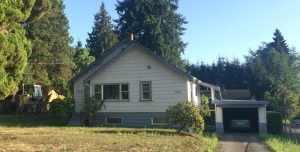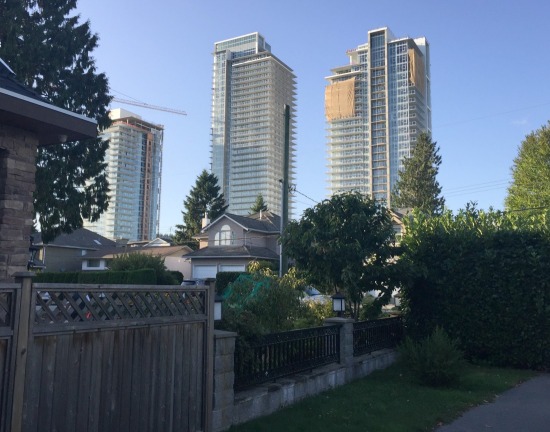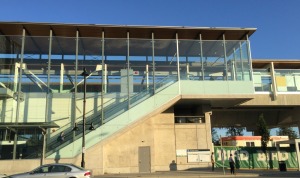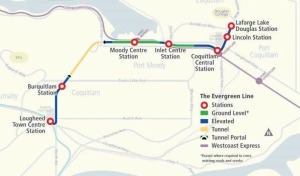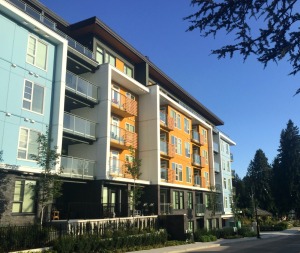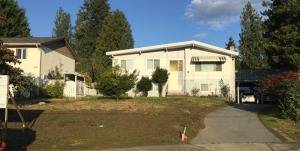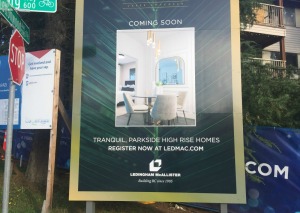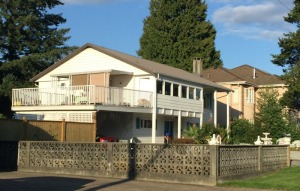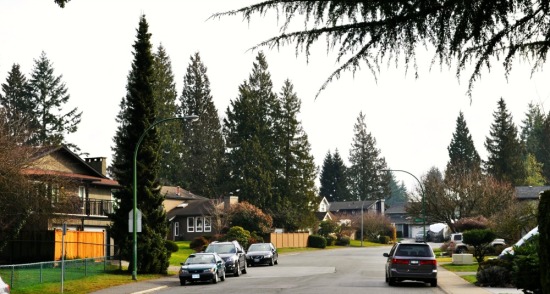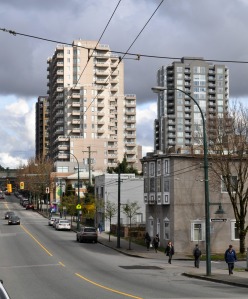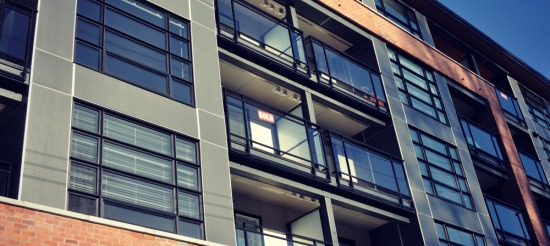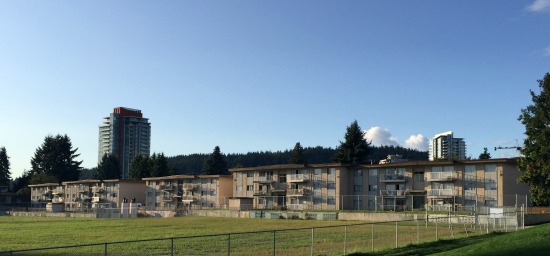
1960s-vintage walk-up apartment buildings near Cottonwood Park. These structures, and others nearby, have housed refugees from the Middle East and Africa in recent years. Many are targeted for demolition. When this photo was taken (October 2019) Google Maps showed a much wider area of similar buildings standing on the now-vacant lands in the foreground.
North Road, which splits Coquitlam from Burnaby, is one of British Columbia’s oldest roads. It was cleared in 1859 as an escape route to the Pacific, in the event that American forces attacked the British military camp on the Fraser River to the south.
Against this dramatic background, the Burquitlam neighbourhood emerged after 1950 as an unremarkable add-on to existing sprawl. The new shopping plaza created a focus of sorts with its enormous parking lot. The funeral home provided another landmark, built close by the early-arrival house shown on the left. In between, the developers added a few blocks of rental apartment housing, something that made sense given the real estate economics and tax policies of the time.
The 2017 opening of the Evergreen rapid transit line is transforming this area. SkyTrain has enabled tower cluster formation around perhaps 20 stations in Metro Vancouver in recent decades; Burquitlam offers an especially drastic example of supercharged redevelopment and demolition, all on the Coquitlam side of North Road. In 2015 there were two mid-rise towers here. Today there are a dozen residential towers located around the North Road/Clarke Road intersection, with more towers, mid-rise complexes and townhomes in the works.
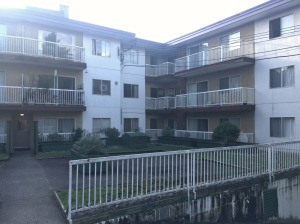
Apartments, maybe 1965, Whiting Way; mostly vacant, and waiting for demolition, on the day of our tour
The story received little attention in community media through 2018 and 2019. I can only conclude that the longtime homeowners — the sort of voters who influence local politics — have not collectively registered any concerns about the pace of change. Granted, the people who are most affected are renters, often new arrivals to Canada who are unlikely to rock the boat. But the owners of big detached homes are sharing the experience, through construction noise, the transformation of viewscapes, and increased traffic on side streets and arterials. The answer may lie in the fact that homeowners anticipate a big payday from the local land boom. In fact, some have already cashed in.
I walked through the neighbourhood with co-tourists Ellen and John Heaney, my sister and brother-in-law. They have owned and lived in a detached house here for more than 30 years, on a street where property values are rising. I was struck by the number of redevelopment notices and properties that have been cleared for redevelopment. In a 2016 post, I wrote about the demolition of the old rental stock around Metrotown in Burnaby and the eviction of renters. My impression from our tour is that the Burquitlam situation is event more acute.
The Metrotown demovictions triggered a protest movement that boosted the Green party’s fortunes in the 2018 local elections. Interestingly, representatives of the Metrotown protest movement arrived in Burquitlam as I was preparing this post. Spokesman Murray Martin told the Tri-City News that Coquitlam has had “a free ride for the last few years” with regard to the displacement of renters.

A 1970s strip mall, the stub of a much larger property that was cleared for the new Safeway and towers in the background.
Ellen was a children’s librarian for many years. She now teaches English to adults and presenting story times to small children through local social service agencies. Her clients are mostly immigrants, especially refugees from war-torn parts of the Middle East and Africa. Some of the people she has taught lived in affordable apartments on Foster Avenue, and were dispersed by the construction of the towers shown above. Others fear they will soon lose their homes.
These are resilient people, my sister says, and quick to form support networks along national or religious lines. Most of them will find their way. Even so, we are looking at a long-term trend where an increasing number of people ejected from affordable housing across the Lower Mainland are competing for a shrinking supply.
The City of Coquitlam has tried to address the rental shortage in its 2015 Housing Affordability Strategy. Unlike in Metrotown in 2016, current project signs in Burquitlam show that the new towers will include some market rental units. However, this is not a one-for-one substitution; the three of us agreed that the new units will probably rent for twice as much as the existing ones.
As in Metrotown, many new Burquitlam residents will be working immigrants, especially Chinese and Koreans. We had our dinner at Katsuya, part of a quasi-trendy Japanese schnitzel chain based at a Burquitlam-like crossroads in Toronto — and part of a diverse Metro Vancouver restaurant market that caters increasingly to Asian tastes.
[This is post #42 in our Urban Villages series.]
